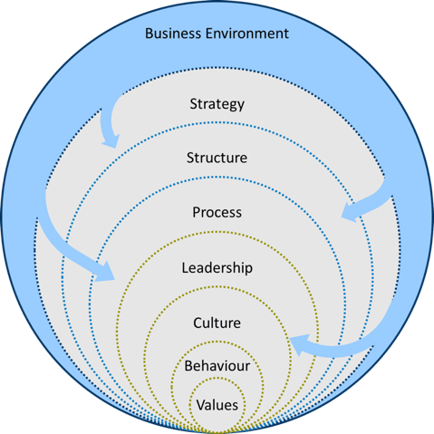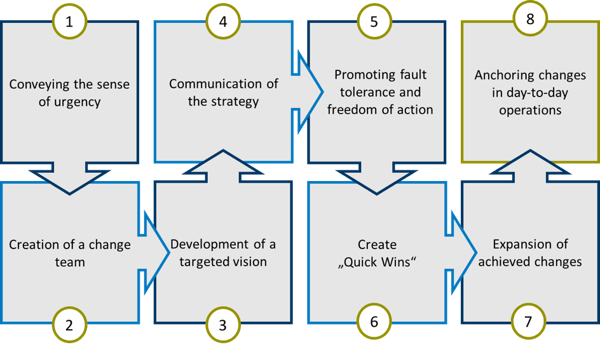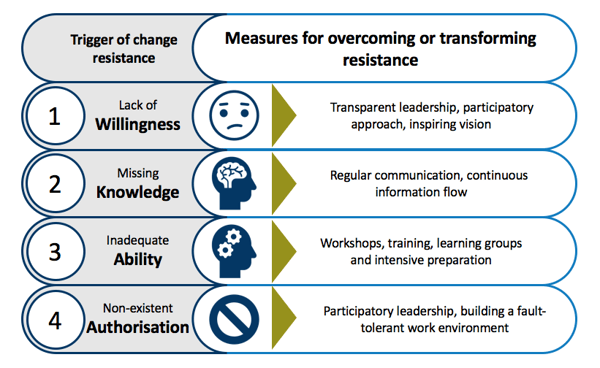Successfully shaping change management
How to manage change successfully in a VUCA world
Change- what does that actually still mean in a working world that is subject to daily change? In a business environment characterized by volatility and complexity, we also have to question our understanding of change management - because the ability to change and agility become crucial competitive competencies. Change is no longer the exception, but becomes a daily challenge and opportunity. In this article we will therefore explain what change management means in a VUCA world, why classical change management models often no longer represent adequate procedures, how they transform change resistance into change energy and which success factors distinguish effective change management in a VUCA world.
What is change management? - A definition
Change management or change management aims at a profound transformation for more efficiency and future security in the company. Today, change management is used in particular to adapt companies to changing environmental conditions and to make them fit for the requirements of the markets in the digital age.
Change management is holistic and encompasses all levers and company dimensions to successfully shape change processes - the strategy and structure of an organization, the processes and management systems, but also the corporate culture, ways of thinking and behaving as well as communication, relationships and management in the company.

Figure 1: Change management and VUCA: The impact of environmental changes on companies
Classical phases of change management
Traditionally, change management processes can be divided into eight phases according to John Kotter:

Figure 2: The typical eight change management phases after Kotter
However, in today's highly dynamic, complex and volatile working environment, such approaches are becoming less and less effective. "Change" is becoming an everyday business and companies should be flexible and adaptable so that changes become "business as usual" (read our book recommendation in which Change Management is understood as'the art of continuous self-renewal'). For example, building a responsive organization with adaptive structures and agile processes or redefining leadership as 'support for self-management' can help. Only in this way can companies become dynamikrobust werden.
Why resistance is natural - and how you can use it
Change management often triggers emotionally stressful change processes at all levels of a company. Such change management processes require motivation and the ability to change. However, change processes often cause uncertainty, fear and resistance among employees. In change management, it therefore makes sense to approach a change process together with change management experts who initiate, accompany, moderate and lead the change to its goal in cooperative partnership.
Important to understand: Resistance is not something fundamentally bad, but a rational reaction to the announcement of change. It is necessary to take resistance seriously, to channel it and to turn those affected into participants. Therefore, it is essential to explore the causes of resistance and to overcome it by means of targeted measures or to transform it into positive energy for change. Figure 3 shows typical causes of resistance to change processes and ways to transform "natural" resistance into positive change energy through targeted measures.

Figure 3: Change management: Trigger for change resistance and measures to transform resistance
The nine success factors for change management in the VUCA world
In order to understand change as an everyday challenge, you can orientate yourself on the following success factors. These enable effective change processes with a lasting effect.
- 1. Think systemically, understand causes, symptoms and effects holistically and in the long term.
- 2. Give a clear answer to the "why".
- 3. To convey an inspiring and participatory image of the goal, to establish a self-reference.
- 4. Use resistance and involve sceptics and critics.
- 5. Build and maintain a competent change team until adaptive structures and culture are in place so that the organization can renew itself again and again.
- 6. Turn those affected into participants and use collective knowledge.
- 7. Do not initiate a holistic, structural and cultural change once, but see it as part of the continuous development of the company.
- 8. To establish clear roles, responsibilities and structures.
- 9. Networking information and exemplifying transparency.
To put these success factors into practice, a healthy attitude towards change is essential: organisational changes, whether on a structural, procedural, emotional, cognitive or strategic level, are normal and necessary. To promote them collectively, courageously and purposefully every day in the face of changing competition is more valuable than any five-year strategy.
Conclusion
"Change is all around us" - Change is not a buzzword, not a trend - in a VUCA world, environmental changes, some of them volatile and opaque, are the order of the day. Organizations that adapt themselves, their culture, structures and strategy to this daily change (without disregarding fundamental corporate values and views) are given the opportunity to proactively shape external change in their own sense.
Your change process can have many reasons. With our change approach, which we tailor to your situation, we support you in implementing your change project. On the basis of our many years of experience in change projects, we offer you a range of services with which we can provide you with meaningful, effective and holistic support for your change project.

